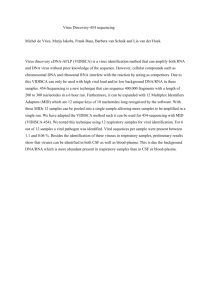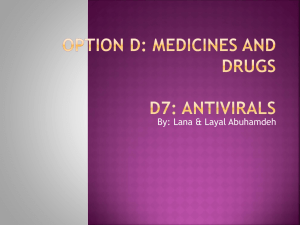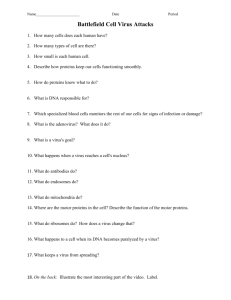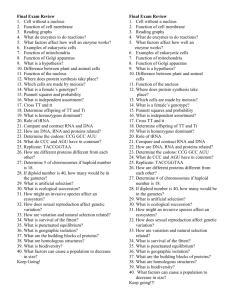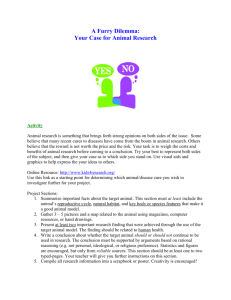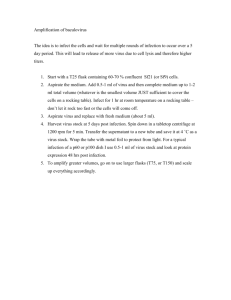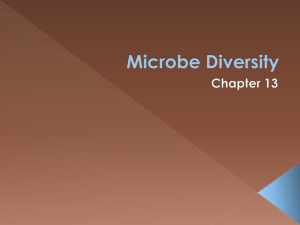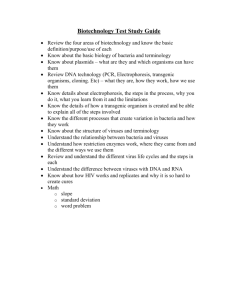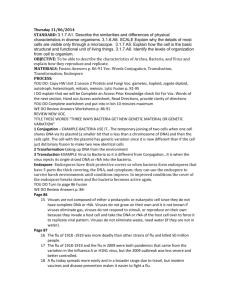Dr. Youssef's Microbiology 20 Notes
advertisement
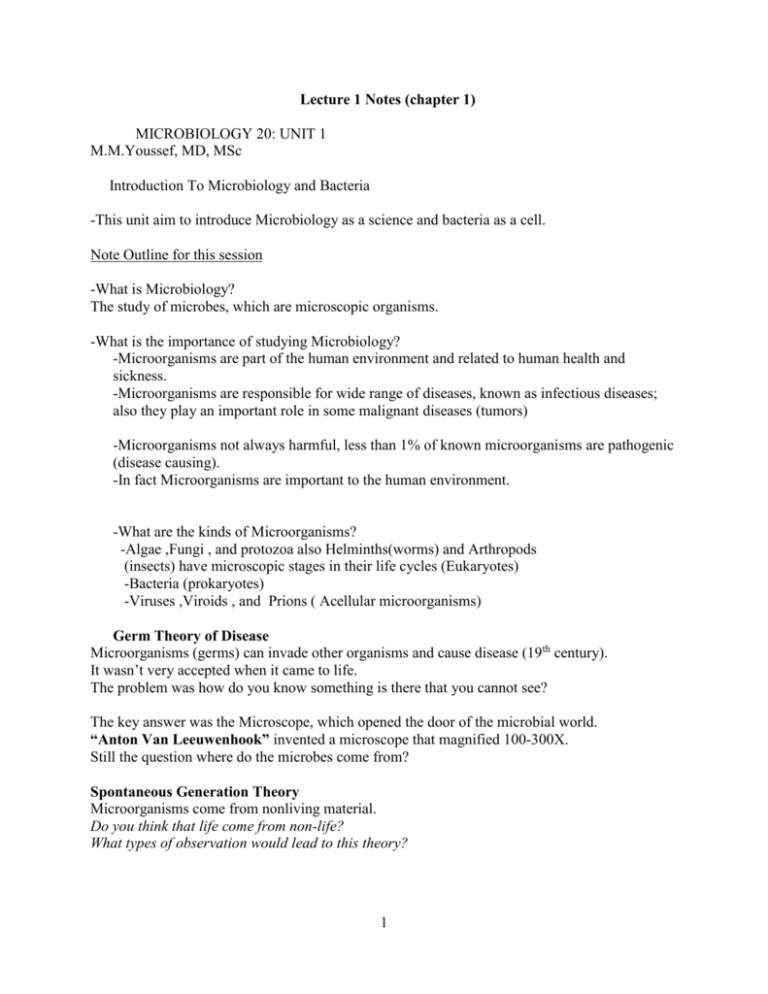
Lecture 1 Notes (chapter 1) MICROBIOLOGY 20: UNIT 1 M.M.Youssef, MD, MSc Introduction To Microbiology and Bacteria -This unit aim to introduce Microbiology as a science and bacteria as a cell. Note Outline for this session -What is Microbiology? The study of microbes, which are microscopic organisms. -What is the importance of studying Microbiology? -Microorganisms are part of the human environment and related to human health and sickness. -Microorganisms are responsible for wide range of diseases, known as infectious diseases; also they play an important role in some malignant diseases (tumors) -Microorganisms not always harmful, less than 1% of known microorganisms are pathogenic (disease causing). -In fact Microorganisms are important to the human environment. -What are the kinds of Microorganisms? -Algae ,Fungi , and protozoa also Helminths(worms) and Arthropods (insects) have microscopic stages in their life cycles (Eukaryotes) -Bacteria (prokaryotes) -Viruses ,Viroids , and Prions ( Acellular microorganisms) Germ Theory of Disease Microorganisms (germs) can invade other organisms and cause disease (19th century). It wasn’t very accepted when it came to life. The problem was how do you know something is there that you cannot see? The key answer was the Microscope, which opened the door of the microbial world. “Anton Van Leeuwenhook” invented a microscope that magnified 100-300X. Still the question where do the microbes come from? Spontaneous Generation Theory Microorganisms come from nonliving material. Do you think that life come from non-life? What types of observation would lead to this theory? 1 “Louis Pasteur” is the one who succeeded to disapprove the spontaneous generation theory (1860). He used three flasks with broth; (1) Left open to air (2) Boiled and left open to air (3) Boiled and left open with curved outlet to air (swan-necked flask) (1) and (2) get turbid (3) stay clean. So,because of Pasteur’s experiments spontaneous generation theory is refused. Koch’s Postulates : Provided method of establishing the specific infectious cause of a disease; 1-The specific causative agent must be found in EVERY case of disease. 2-The disease causing organism must be isolated in a pure culture. 3-Inoculation of a sample of the culture into a healthy susceptible animal must produce the same disease . 4-The disease causing organisms must be recovered from the inoculated animal. According to these postulates he assumed that an infectious disease is caused by a single organism (one organism-one disease concept) Do you think it is perfect? Why? 2 LECTURE 2 NOTES (chapter 4) What Is a Cell? Cells are the fundamental units of life and carry out all the basic functions of living things. (Cell Theory) What do the cells need? 1-Barrier from the environment (cell membrane) 2-Genetic infomations (DNA, Nucleolus) 3-Proteins to do stuff. Two types of cells: PROKARYOTIC - have no membrane enclosed organelles, only one membrane surrounding entire cell, they all are single celled organisms (bacteria) EUKARYOTIC –have membrane enclosed organelles, a nucleolus, multicellular or single celled organisms Prokaryotic cells (bacteria) varies in size, shape, and arrangements, but they all multiply by Binary Fission, rather than mitosis or meiosis Bacterial cell wall: semi rigid cell wall lies outside cell membrane in most bacteria, and it performs two main functions: 1-Maintain the characteristic shape of the cell. 2-prevents the cell from bursting by fluid diffusion into the cell. -Peptidoglycan: The major component of a cell wall. Large polymer ,covalently linked molecule, like a large, multiple layers of chain-link fence surrounding the bacterial cell (This is a very specific bacteria thing) It is composed of sugar and peptides. Sugars (backbone): N-acetylglucosamine (glu NAC) N-acetylmuramic acid (mur NAC) Cross-linking: Tetra peptide, (chains of four amino acids joined together), [L-alanine, D-glutamic acid, Diamino Pimellic acid (replaced by Lysine in most gm +ve bacteria and D-alanine] Gram-positive bacteria have an additional molecule in the cell wall, called “Teichoic acid”; it’s a huge polymer that sticks out of cells (extends beyond the rest of the cell wall, providing attachment sites for bacteriophages) 3 N.B. Peptidolycan, forms a large supporting network around the bacterium, but doesn’t hold things in and out” it is porous”. It is found in both gram-positive and gram-negative bacteria, but it is much thicker in grampositive cells. -Outer Membrane: It is a bilayer membrane, found primarily in gram-negative bacteria. It forms the outermost layer of the cell wall and is attached to peptidoglycan by small lipoproteins molecules. Outer membrane protects the cell, exerts little control over the movement of substances in and out the cell, it also inhibits the entrance of penicillin into gram-negative bacteria. Lipo polysaccharide (LPS) It is also called” Endotoxin’. It is important part of cell membrane and it is an integral part of the cell wall and it is not released until the death of bacteria (cell wall lyses). It is composed of polysaccharide (sugars that identify gm-ve cells) and lipid A (toxic part), its release causes fever and blood vessels dilatation, which causes drop of blood pressure (hypotenstion). N.B. Antibiotics given late in gm-negative infection may worsen the condition and cause death. -Periplasmic space: Highly evident in gram-negative bacteria, it is a gap between the cell membrane and the cell wall. It represents a very active area of cell metabolism, as it contains peptidoglycan. Many digestive enzymes and transport proteins,that destroy harmful substances and transport metabolites into bacterial cytoplasm. In gram-positive, the periplasm (not periplasmic space) is where metabolic digestion occurs and where new cell wall peptidoglycan is attached (it is more like a part of the cell wall). Distinguishing bacteria by cell walls Certain properties of cell walls produce different staining reactions, which can distinguish between gm-positive, gm-negative and acid fast bacteria. 1- Gram-positive bacteria: Peptidoglycan layer periplasm . Cell membrane Cell wall is relatively a thick layer of peptidoglycan (60-90% of cell wall), which is closely attached to the outer surface of cell membrane (no periplasmic space) They retain gram stains because of their thick layer walls and their structures. At time, cell walls are weaker “breakdown of peptidoglycan), which could become Gram-variable or even Gram-negative. 4 2-Gram-Negative Bacteria: Cell wall is thinner but more complex than gram-positive bacteria. Only 10-20% of cell wall is peptidoglycan, the remainder consists of polysaccharides, proteins and lipids. They fail to retain Crystal Violet-iodine dye because of their thin walls and its structure (lipoproteins and lipopolysaccharides). 3-Acid-Fast Bacteria (Mycobacteria): -Lipids around cell protects from most stains (60% of cell wall). -Lipid wall likely inhibits nutrients,” so it grows slowly”. -They stain gram-positive. -Large layer of lipids in the cell wall protects from acids, alkalis and detergent. But requires a lot of nutrients. Members of Mycobacteria family include Mycobacterium tuberculosis, Mycobacterium leprae, and Mycobacteria avium. Wall-deficient Organisms Mycoplasma have no cell walls. The cell membrane contains sterols (more like Eukaryotic cells). They don’t have cell shape (pleomorphism) and are still subject to osmolarity changes. L-Forms are wall-deficient bacteria (naturally or by chemical treatment). They can cause chronic or recurrent infection, if they rebuild their cell walls (they don’t killed by antibiotics that affect cell wall. 5 Lecture 3 notes(chapter 4) Cell Membrane (Plasma membrane, Cytoplasm membrane) It is a living membrane that forms a barrier between the cell and its environment. Bacterial cell membrane has a similar structure to other cell membranes ( Eukaryotic cell). It consists mainly of phospholipid and proteins, where, phospholipids in the membrane are in fluid state and proteins are dispersed among them. (Fluid-mosaic model). Phospholipid membrane forms a bilayer with: -Phosphate ends that extends toward the membrane surface. They are charged and hydrophilic (water-loving). So, they can interact with watery environment. -Fatty acid ends extend inward, they are non-charged and hydrophobic (water-fearing). So, they form a barrier between the cell and its environment. Protein molecules are interspersed among the lipid molecules. Cell membranes are dynamic, materials move through it in a sensitive way. What are the functions of cell membranes? Internal Structure: Cytoplasm: It is a semi fluid substance inside the cell membrane. It is made up of 80% water and 20% of dissolved stuff; it is like a suspension that contains enzymes, proteins, carbohydrates, lipids, and inorganic ions. Nuclear regions: Unlike Eukaryote, there is no nuclear membrane. It contains one large circular piece of DNA (chromosome). There are sometimes smaller circular pieces called “plasmids’(plasmid is supplementary and not critical to cell survival). Ribosome: Ribosome Consists of RNA and proteins. -Can be grouped in long chains called” polyribosomes”. -They are the sites of protein synthesis. -Ribosomes are spherical in shape, they contain two subunits, large (50 S) and small (30S). Both together are (70S), which is smaller than Eukaryotic ribosome’s (80S). N.B. Certain antibiotics, e.g. ”Erthromycin and Streptomycin”, bind to 70S ribosomes and disrupt bacterial protein synthesis without affecting the host cells. Endospores: Vegetative cells…actively metabolizing nutrients Resting cells…No nutrients …(Resting stages)…..Endospores 6 Endospores are very common in Bacilli and Clostridium Bactreial endospores (single per cell),they help organism to survive, unlike fugal spores, that are for reproduction Endospores ,are formed within cells,they contain very little water,they are highly resistant To heat,drying,acids,bases,radiations,and disinfectants. They help bacteria to survive for long times in harsh conditions. External Structures. Flagella (movement structures in motile bacteria), Axial Filaments (in Spirochetes), Pilli (attachment and conjugation), and Glyocalyx. Let us move on to a Eukaryotic cell: Plasma membrane, comparable to cell membrane Sterols, used in plasma membrane to keep rigidity and still retain fluid mosaic model Cell Nucleus Surrounded by nuclear envelope Nuclear pores let things in and out (like what) Nucleoplasm is the inside plasma of the nucleus Nucleoli are sites of ribosome assembly (made up of RNA and proteins) Paired chromosomes of DNA, which are compacted together with proteins called histones. Chromatin is the protein/DNA mix that gives the nucleus a granular appearance. Division of eukaryotes is by Mitosis and Meiosis. Mitochondria Powerhouse of the cells Many in each cell Have Outer membrane, inner membrane and a “matrix” inside These organelles make ATP (the energy source for cells) Ribosomes Bigger than bacterial, made up of RNA and protein (80S) Endoplasmic Reticulum Network of membranes Smooth is where lipids are made Rough has ribosomes attached for making proteins Golgi Apparatus (named after Golgi) A stacks of membranous sacs, gets stuff from ER and alters their chemical structures, and packing them in secretory vesicles. It also makes the Lysosomes, which are vesicles that contain digestive enzymes. 7 Lecture 4 Notes(chapter 5) Bacterial metabolism: Metabolism is the sum of all chemical processes carried out by living organism. It includes anabolism and catabolism. Anabolism is the reactions that require energy to synthesize complex molecules from simpler ones. Catabolism is the reactions that release energy by breaking complex molecules into simpler ones. All catabolic reactions involve electron transfer, which allow energy to be captured in highenergy bonds in ATP. _Oxidation is ‘loss of electrons’. _Reduction is “gain of electrons”. How microorganisms obtain energy? Microorganisms are classified as: Autotrophy (self-feeding) or Hetrotrophy (other-feeding) Nearly all microorganism infections are chemoheterotrophs. Metabolic pathways can be catabolic (produces energy that cell can use), or anabolic (uses energy to make structural complexes, enzymes and other functional molecules. ATP molecules are the links that couple anabolic and catabolic pathways. Enzymes are special category of proteins found in all living organisms. Chemical reactions that release energy needs energy to start the reaction, which is called “Activation energy”. Enzymes lower the amount of activation energy needed to initiate the reaction, thus they make it possible to occur at relatively low temperatures that living cells tolerate. Enzymes also provide a surface on which reactions take place. Each enzyme has a certain area on its surface called “the Active site (binding site)”; it is the region at which the enzyme binds (forms a loose association) with its substrate. When the substrate binds to the active site of the enzyme, they form enzyme-substrate complex. Which leads to a chemical change in substrate that results in product formation and enzyme detachment. Enzymes have a high degree of specificity, they catalyze only one type of reaction, and most act on only one particular substrate. The active site accounts for the enzyme specificity. Enzymes are usually named by adding (suffix-ase) to the name of the substrate on which they act. Enzymes can be divided into endoenzymes and exoenzymes according to their site of action. Many enzymes need to associate with non-protein substances called ‘coenzymes or cofactors’, so they can catalyze their reactions. A Coenzyme is a non-protein organic molecule that bounds to an enzyme. Many of them are synthesized from vitamins, e.g. coenzyme A, NAD, and FAD. 8 A cofactor is usually an inorganic ion, e.g. iron, zinc, or magnesium. Cofactors often improves the fit of an enzyme with its substrate, also they are essential for the reaction to proceed. N.B. Carrier molecules such as coenzymes carry hydrogen atoms and electrons in many oxidative reactions. The cells need to inhibit (control) its enzyme activities by different methods; A- Competitive inhibition B- Non-Competitive inhibition C- Feedback inhibition Factors that affect the rate of enzyme reactions include: temperature, PH, and concentrations of substrate, product and enzyme. Most human enzymes and those of human- infecting microbes have an optimum temperature near normal body temperature and an optimum PH near neutral, at which they catalyze reactions most rapidly. 9 LECTURE 5 NOTES(chapter 5) Glycolysis, Fermentation, and Aerobic respiration are the metabolic processes used by most microorganisms to capture energy. -Glycolysis ( Embden-Meyerhof pathway) is the metabolic pathway used by most organisms (both aerobes and anaerobes) to breakdown glucose. It consists of 10 steps, but the most important steps are: 1- Phosphorylation of glucose (transfer of phosphate group from ATP to glucose). 2- Breaking of glucose (six-carbon molecule) into two (three carbon molecule). 3- Transfer of two electrons to the coenzyme NAD. 4- The capture of energy in ATP. Glycolysis (glucose oxidation or breakdown) result in a net energy capture of only two ATPs per glucose molecule, as one glucose molecule is metabolized by glycolysis into two molecules of pyruvic acid. Also, two molecules of reduced NAD (NADH) are also produced. Once the sugar has entered glycolysis , it is metabolized to pyruvic acid and then fermented or metabolized aerobically. -“Fermentation”, is a process by which pyruvic acid undergoes subsequent metabolism in absence of oxygen. Fermentation aim to pass the electrons from reduced NAD (NADH) off to other molecules (NAD recycling). It doesn’t result in capture of energy in ATP, but it helps energy capture indirectly by keeping glycolysis going. The most important and commonly occurring pathways are Homolactic acid fermentation and Alcholic fermentation. Other kinds of fermentations are performed by some microorganisms can be important in diagnosis of microbial infection and identifying the causative agent. Aerobic organisms obtain some energy from glycolysis and they use it to produce more energy from glucose by aerobic respiration via the krebs cycle and oxidative phosphorylation . -Krebs cycle ( tricarboxylic acid cycle or citric acid cycle) It is a sequence of reactions in which, acetyl groups are oxidized to carbon dioxide. Hydrogen atoms are also removed, and their electrons are transferred to coenzymes that serve as electron carriers. (The hydrogens are eventually combined with oxygen to form water). Certain events in the krebs cycle are of special significance: -Oxidation of carbon. (Give carbon dioxide) 10 -Transfer of electrons to coenzymes. -Substrate level energy captures. Electron transport and oxidative phosporylation: They can be modeled as a waterfall series. As the electrons are passed from carrier to carrier in the chain, they decrease in energy, and some of the energy they lose is directed to make ATP molecules (energy stores). From the metabolism of a single glucose molecule, 10 paris of electrons are transported by NAD and only 2 pairs by FAD. Krebs cycle give atotal yield of 38 ATPs per glucose molecule(10 pairs of electrons from NAD produce 30 ATPs, 2 pairs from FAD produce 4 ATPs, in addition to 2 ATPs from glycolysis and 2 GTPs from krebs cycle that transferred eventually into 2 ATPs) Oxidative phosphorylation generates much more energy than fermentation, which produces only 2 ATPs (about 5%). The theory of chemiosmosis explains how energy is used to synthesize ATP. Anaerobic respiration done in anaerobes that don’t use free oxygen as their final electron acceptor. They only use parts of kerbs cycle and the electron transport chain; thus, they produce less ATP molecules than aerobic organisms. Fat metabolism . fats (lipids) are hydrolyzed into glycerol and fatty acids. The glycerol is metabolized by glycolysis and the fatty acids are oxidized by beta-oxidation after they combine with coenzyme A ,forming Acetyl-CoA that enters the krebs cycle. Proteins can also be metabolized for energy. They are first hydrolyzed into amino acids that are deaminated (amino group is removed), and then the deaminated molecules can enter glycolysis, fermentation or the krebs cycle. What are the uses of energy in microorganism? 11 Lecture 6&7 (chapter 7) Microbial genetics Gene (a specific segment of DNA) is the basic unit of heredity; it is a linear sequence of nucleotides that form a functional unit of chromosome. DNA structure is a: Double helix Anti-parallel (5’-> 3’ and 3’<- 5’) Strands are bound by lots of weak hydrogen bonds A to T G to C DNA replication occurs by three main things happening: Unwind the DNA (by a helicase) Prime the strand of DNA (by a primase) Make more of the DNA polymer (by a DNA polymerase) DNA replication is important to make more of the genome for the daughter bacteria cells DNA replication occurs in a semi-conservative manner in which one strand of the double helix is new and one is old.. Moving on to Transcription Central Dogma: DNA is TRANSCRIBED to RNA that is TRANSLATED to PROTEIN Transcription will turn DNA into RNA. (in cytoplasm for bacteria, in nucleus for eukaryotes) Notice that : ORF = open reading frame, the information that will be translated to a protein Promoter = the DNA that marks the area where an ORF starts RNA: mainly single strand of nucleic acid. Same bases as DNA, except T is a U… so if you see U in a sequence it is RNA, T in the sequence and it is DNA! RNA polymerase comes to a promoter and the big protein set will begin to unwind the DNA a little bit. Then it starts putting RNA bases there and keeps on extending the length of RNA, in 5’ to 3’ direction. RNA and DNA both grow in 5’ to 3’ direction. When the RNA polymerase reaches the end of the gene, the mRNA is finished and ready to do something. The mRNA will be the RNA version of the DNA strand and complementary to it. 12 Notice the differences and similarity: DNA Polymerization RNA Polymerization Starts at Origin of replication Promoter DNA opens by DNA Helicase RNA polymerase Primer protein DNA primase no primer required Primer type RNA no primer required Grows in 5’ to 3’ 5’ to 3’ Polymerase DNA polymerase RNA polymerase Stops at When done End of Gene Types of RNA RNA does things, there are 3 types mRNA = messenger RNA this is RNA that will be directly translated by ribosomes,it serves as a template for protein synthesis as it consists of codons(sequence of three bases).Each codon specifies a particular a particular amino acid or acts as a terminator codon. rRNA = ribosomal RNA this is RNA that will be incorporated into the ribosome (the ribosome is special and made up of RNA and proteins together), it is responsible for reading of mRNA and serves as a binding site for tRNA . tRNA = transfer RNA this is RNA that is a bridge between RNA and proteins. Its function is to transfer amino acids from the cytoplasm to the ribosome for placement in a protein molecule. Remember: Proteins are made of amino acids, there are twenty in all mRNA is translated because of a few features of it. First it has a string of bases that can be translated to proteins. This translatable bases are actually as set of codons, or three bases of RNA that work as a group… so RNA is read three letters at a time… each of these codons is a word to the ribosome. The mRNA ORF is started by a start codon and stopped by a stop codon. The start codon is AUG. once the ribosome notices a start codon, it will start translating the RNA in steps of three (one codon at a time) making each codon into a new amino acid linked to the growing protein. Draw a tRNA showing anticodon (to bind to mRNA codon) and clover like and also charged amino acid at top Ribosomal Translation Central Dogma: DNA is transcribed to RNA which is translated to proteins Always happens in cytoplasm though ribosomes and RNA made in nucleus for eukaryotic cells. 13 A ribosome recognizes the beginning of the mRNA and will attach to it and look for the Start codon. Once there is stops and brings in a tRNA whose anti-codon matches AUG. That tRNA has a Methionine amino acid always. Then is holds it there, looks at the next codon. GUCAUCCUGGUCUGCA AUG GAU GAU GAU AUC GCC GCG CUC GUC GUC M D D D I A A L V V The next codon is for aspartic acid and so the ribosome gets a tRNA whose anti-codon matches the GAU and then links Methionin and Aspartic acid amino acids by a peptide bond. (Same type of bond as in peptidoglycan). The Methionine is let loose from its tRNA and the free tRNA exits the ribosome as the ribosome moves to the next codon. This continues to go one… label the acceptor site (where a new tRNA comes in), the protein site, where all the amino acids are linked and the exit, where the free tRNA leaves… it continues until it reaches a stop codon and then free protein is made. Mutation: Is a heritable change (permanent alteration) in the sequence of nucleotides in DNA. -Genotype refers to the genetic information contained in the DNA of the organism. -Phenotype refers to the specific characteristics displayed by the organism (physical expression of genotype). -Mutations always change the genotype. Such a change may or may not be expressed in the phenotype depending on the nature of the mutation. Point mutation : is a single base substitution (nucleotide replacement). This mutation changes a single codon in the mRNA, and may or may not change the amino acid sequence in a protein. Silent mutation is a point mutation that produces the same original amino acid (no change in phenotype) Frameshift mutation : is a mutation in which there is a Deletion or an insertion of one Or more bases. Such mutations alter all the three-base sequences beyond the deletion Or insertion and change the amino acid sequence in a protein or stop the protein synthesis when a terminator codon is introduced. -Spontaneous mutations occur in absence of any known mutagen due to errors in base pairing during DNA replication, while Induced mutations produced by mutagens. -Mutagens are chemical and physical agents that increase the mutation rate above the spontaneous mutation rate. What are the commonly known mutagens?? 14 LECTURE 8&9 (Chapter 10 VIROLOGY & CANCER BIOLOGY ) Viruses are microbes that REQUIRE a host cell to replicate. By themselves they cannot replicate. They border on the edge of living and non-living. Without a host cell, they cannot reproduce or do anything. With a host cell, they can make more of themselves. Viruses are composed of several components: 1) Nucleic Acid (either DNA or RNA) which holds the genetic information for the virus 2) A capsid (protein coat) to protect the nucleic acid 3) An envelope When a virus exits the cell, it does so by exocytosis in which the virus buds out through the plasma membrane and thus creates a surrounding bubble of plasma membrane 4) Spikes (outer surface projections) These are glycoproteins in the envelope that allow the virus to interact with a host cell and begin its entry (by receptor endocytosis) Viruses can infect animals, plants or bacteria (bacteriophage) Cell specificity: Just because a virus is near a cell, does not mean a virus can infect the cell. If it does not have the right type of receptor to interact with the spike, it will not enter. If it does not have the right cell machinery it will not infect. Host range is the types of cells inside an organism that a virus can infect. Host range also means what animals a virus can infect. Not all viruses can infect all animals. Classification: The old scheme was based on the host range. All neurotropic viruses are the same, all lung-tropic viruses are the same… Tropism is where a virus can infect. Now, classification is based on the genetic material (DNA or RNA) inside a virus. Viruses can have either RNA or DNA (but rarely both). It can be double stranded (ds) or single stranded (ss) Positive Stranded vs Negative stranded (+) RNA is like mRNA: It can be directly translated to proteins (-) RNA is the reverse complement of mRNA: It CANNOT be directly translated into proteins; it must be turned into a (+) RNA Naked versus Enveloped Naked: Just a protein coat around nucleic acid of the virus Enveloped: a sphere of plasma membrane surrounding the protein coat that is surrounding the nucleic acid of the virus. 15 RNA families of viruses : Picorna Virus +RNA, naked Enteroviruses – Polio virus: Caused severe paralysis due to nerve damage (Remember FDR, the president, he was in a wheel chair) Hepatovirus – Hepatitis A: Causes liver damage. Hepatitis is a general term for Liver damage, thus each Hepatitis virus is in a different family Rhinovirus – Causes the common cold, more than a 100 types Toga viruses +RNA, enveloped Rubella – Common in children, MMR has stopped commonality in USA Flavi viruses +RNA, enveloped Yellow fever – Causes a hemorrhagic fever, which is uncontrolled bleeding Major problem in central America during panama canal Hepatitis C – Causes severe liver damage and influences liver cancer Paramxyo viruses -RNA, enveloped Mumps, Measles – gone in US due to MMR (measles mumps rubella vaccine for young children) Rhabdo viruses -RNA, enveloped, looks like a bullet Rabies is major disease Orthomyxo viruses -RNA, enveloped, has multiple segments of RNA (segmented genome) Influenza A – different strains infect different animals and birds. Influenza B – mainly infects humans Filo viruses -RNA, enveloped, long filaments Marburg and Ebola viruses are the only two members of this family Highly pathogenic hemorrhagic viruses (causes a lot of bleeding) Filo viruses can infect MANY cell types… their receptor for the spikes are on many cells throughout the body and thus cause a lot of damage. 16 Bunya virus -RNA, enveloped Hantavirus- causes hantavirus pulmonary syndrome (HPS). Arena viruses -RNA, enveloped Lassa fever and hemorrhagic fevers. Reo viruses dsRNA, naked Rotaviruses cause severe diarrhea in infants and young children DNA Families of viruses: Adeno viruses Linear dsDNA Causes acute (quick) respiratory and other infections. Herpesviruses Large, linear dsDNA characterized by Latency Herpes Simplex 1 – Mouth Sores Herpes Simplex 2 – Genital Sores Varicella Zoster – Chicken Pox (varicella)and Shingls(zoster). Cytomegalovirus – Dangerous for children at birth if mother is secreting virus from vagina during birth (birth defects). Roseolla virus – causes roseolla (fever and rash)in children. Epstein-Barr virus – cause of infectious mononucleosis, also linked with cancers such as Burkitt’s lmphoma and Hodgkin’s disease. Kaposi’s Sarcoma Associated Virus – cause of Kaposi’s Sarcoma in AIDS patients and also causes other cancers in the elderly as well Poxviruses Large dsDNA viruses Cause of Smallpox Smallpox is eradicated except for two vials in the world Vaccine was made from vaccinia, a virus that infected cows Vaccinia is also a pox virus Cause of Moscullum Contagium A relatively uncommon disease, , it presents as small raised white tissue on gentials, especially the penis and is especially common in AIDS patients Papova viruses Small dsDNA Papilloma- common infection of woman (and men) but targets the cervix and vaginal walls and some papilloma strains are highly associated with cervical cancer. Vaccination against these cancer-inducing strains can reduce the incidence of cervical cancer ,other strains cause warts in humans. Polyoma viruses cause renal disease in immunodeficient. 17 Vacuolatis – SV40 causes cancer in monkeys, used in research. Hepadna viruses – ONLY member is Hepatitis B Virus dsDNA enveloped Persistant infections of the liver Long term causes a lot of liver damage, can lead to hepatocellar carcinoma. Parvo virus Naked, linear ssDNA Adeno associated virus – can make adeno virus infections worse Erythro(B19) virus – Cause of fifth disease Hepatitis D – only seen in Hepatitis B infected patients, caused by the additional infection of Hepatitis delta, a viroid (the only human one) Hepatitis D, causes massive, rapid liver damage IV: Viral Carcinogenesis (Mainly from Notes) Development of Cancer Cancer is a disease of uncontrolled growth of our cells. Normally our cells only grow enough for what is needed in the body. The growth of cells is controlled by two types of proteins in our cells (1) proto-oncogenes and (2) tumor suppressors. These proteins either allow a cell to grow right (for the proto-oncogenes) or stop the cell from growing wrong (tumor suppressors). Mutations that develop in one particular cell in our body could affect the function of either of these two types of proteins and lead to uncontrolled growth of the cell. This leads to massive growth of the cell over many years and the inability for our body to handle it. This process of cancer development if oncogenesis or neoplastic transformation. A neoplasm is another word for a cancer. Multiple mutations are required for cancer development. Some retroviruses can actually start the process of oncogenesis directly. Examples of human cancer causing retroviruses are HTLV1 and HTLV2 (Human T Cell Leukemia Virus). A cancer causing retrovirus transduces cells and begins producing its own genetic information, BUT it also brings in its own genes. There are two ways it can start oncogenesis (1) is by making proteins that bind to tumor suppressors or (2) by bringing in mutant forms of proto-oncogenes, theses mutated proteins are called oncogenes. Thus the virus is making a cell grow uncontrolled. This allows for an indirect expansion of the virus because now there are more cells that have the virus and thus more copies of the virus around. But, this also leads to more cells and later to mutations in those cells that lead to full blown cancer. Viruses usually only initiate cancer, cancer takes a long time to develop and usually becomes a major disease after many mutations. There are other types of cancer causing viruses. Examples are te Herpesviruses such as EpsteinBarr Virus (EBV) and Kaposi’s Sarcoma Virus (KSHV). EBV causes Burkitt’s Lymphoma and KSHV causes Kaposi’s Sarcoma (a cancer like disease of the skin) and other lymphomas. Herpesviruses do not transduce the cells they infect, but rather, they 18 often setup a Latent infection where their genomes (DNA genomes already) persist in the nucleus of the infected cells. When the cells are stressed, they exit the Latent form and switch to a Lytic form that kills the cell, but produces many new virions. Latency often enhances cells growth by virus made oncogenes, These proteins enhance cell growth to make more of the latent virus and often will lead to cancer as well. Here we focus on HPV-16, a very oncogenic form of papilloma virus. Recently, a vaccination against this virus has been developed which is very efficacious against the development of HPV-16 induced cancers. Cancer will not develop just with a viral infection, a second “hit” or mutation is required for full blown cancer. How do you stop cancer? Even though mutations started cancer, enough mutations in a cell will eventually lead to the cancer cell’s death. Thus the drugs that are given cause mutations in cells that grow very fast. Unfortunately, this includes the cells of our hair, intestinal tract and our white blood cells. Cancer therapy is a balance between killing our cells and killing the cancer. V: AIDS and HIV (Mainly from Notes) Human Immunodeficiency Virus is the virus that causes AIDS (acquired immuno deficiency syndrome). AIDS patients were first reported in 1981 as five men in Los Angeles. In the early 1980's AIDS was a very deadly disease, which was manifested as people coming down with VERY rare diseases. AIDS is the state where the immune system is so weak that it cannot fight off infections (viral, bacterial, fungal, etc) or cancer (leukemias, lymphomas, Kaposi's Sarcoma) that it normally could fight off. In 1986, HIV was discovered. It is a retrovirus that is able to infect immune cells. The cellular tropism, or cellular specificity of HIV is for T cells, or CD4 Cells of the immune system. In addition, HIV can infect all CD4 cells. Another CD4 cell is a macrophage. Macrophages as you remember are able to phagocytoze and degrade bacteria in their lysosomes. 19 HIV has three main genes, (1)gag, (2)pol, and (3)env. gag is the gene for the protein coat, pol is the gene for the reverse transcriptase and env is the gene for the outer spike that attach to the receptor on the cell it will infect. In 1987, the first anti-HIV drug was released: AZT (Azidothymidine) AZT targets the reverse transcription step of the HIV replication. There it forces the reverse transcription to make a lot of errors and thus mutate the virus beyond its ability to function. Over time, many of these reverse transcription inhibitors, or nucleoside inhibitors were developed, but in time, the virus was able to mutate to avoid this drug. The second class of anti-HIV drugs developed, in 1996, were the protease inhibitors. These drugs target the HIV protease, which is a HIV protein that changes the proteins coat from the initial immature form that is released from an infected cell, to a mature form. Without the protease, the immature HIV is not able to infect as well. These two types of drugs were in a combinatorial, or cocktail type of treatment (2 nucleoside inhibitors, 1 protease inhibitor) to target multiple genes and stop the ability for HIV to mutate against the drugs. This was called HAART, Highly Active Anti-Retroviral Therapy. The biggest problem with this therapy is that the virus can in fact mutate over time, and this is often due to patients unable to follow the treatment (nonadherance) or unable to pay for so many drugs. Thus mutant forms of HIV exist that are resistant to HAART. A third target of anti-HIV drugs is the fusion step. When a virus’s spikes attach to the receptors of the cell that it will be infecting, HIV gets closer and allows the spikes to fuse the envelope and the plasma membrane of the cell that it is infecting. Fusion inhibitors have been developed which bind to the spikes right before they start fusion and freeze the virus in place. No fusions occur and thus no infection happens. The first fusion inhibitor was released a couple of years ago and is called Fuzeon. The major problem is that this drug is only injectable because it is a protein and proteins are degraded by the stomach. Thus this drug is effective but used only after HAART fails.As of yet, there is no cure for HIV, only the ability to control the virus. 20 Lecture Notes 10&11: Chapter 16 (Nonspecific Host Defenses and Host Systems) some Chapter 14 and 17 Normal flora is the set of bacteria that normally live on (skin) or in (intestines) our body. These bacteria does not overgrow and lives a very plain existence The body keeps these bacteria in check. Normal flora is the set of bacteria that live on or in us An infection begins when a microbe begins to grow in our body and it is not a normal flora. Usually it overcomes our many natural defenses. Infections are diseases that are not part of normal flora or are no longer controlled, or have access to new parts of our body. There are two types of defense systems in our body 1)Specific – Respond to a particular pathogen, but even more specific than just that, they respond to a particular antigen. (For example, we respond very specifically against influenza that we were vaccinated against, but we don not respond to a new strain of influenza.) . The specific defenses induce a much stronger action against the second round of infection of the same organism versus the first round (this is immune memory and the basis behind vaccination). Specific Defenses involve the production of proteins called antibodies(Immunoglobulins) Antibodies can specifically recognize a small part of an infection often as little as a few amino acids. Often particular cells are involved in this process, lymphocytes. Nonspecific – Nonspecific defenses are against general types of infection, or all infections. These often work before the specific defenses are activated. Nonspecific defenses include: Physical barriers such as the skin and mucous membrane. They are physical barriers and also, there is much surface to secrete anti-microbial substances. Skin is a physical barrier, but a major site of infection is when a cut or tear occurs. Skin also has a chemical in it call defensins which can poke holes in bacteria Skin also has Langerhans cells, which are skin macrophages The Skin is a major physical barrier to infection, only breaks or tears in skin allow for entry of microbes Defensins are anti-microbial proteins released by cells. 21 Mucous Membranes, cover the inner linings of the insides that are exposed to the outside environments (lungs, nose, mouth, digestive tract, vaginal lining) Mucous membranes in the nose and respiratory systems present have hairs and mucus, which is a mechanical barrier to entering. Mucous membranes often have movements that move mucus around and also the hairs move in patterns. Mucus physically stops the movement of microbes. Physical movements within these areas also are defenses: Cough, Sneeze, Vomiting, Diarrhea, also do tears, saliva, and urine flow. Severe physical movements often are to expel potential pathogens. Chemical barriers are in body fluids such as Lysozyme in tears, saliva and mucus. Skin sweat and sebum and gastric acidity,and transferring in blood all are anti-microbial. CELLULAR DEFENSES Normally blood is composed of 60% plasma (the liquid) and 40% formed elements, the cells. Cells in the blood include erythrocytes (red blood cells), platelets (the blood clotting things) and white blood cells (lymphocytes and the such). Erythrocytes = Red Blood Cells Platelets = Blood clotting agents White Blood Cells = Immune Cells Cells that are in the nonspecific defenses Granulocytes are cells that are have a lot of granules (small distinct sphere like things in the cytoplasm) and often release what is stored in granules near an infection. These types of cells include: Basophils – release histamine which induces inflammation of the area Mast Cells – also release histamine and are associated with allergies Eosinophils – important in worm infections and also turn off inflammation Neutrophils – first to respond to an infection (arrive at location of infection) INTRACELLULAR KILLER Macrophages are nongranule and are important in the uptake of bacteria (and the subsequent degradation of the bacteria) There are many tissue specific (fixed)types of Macrophages Alveolar (lungs), Kupffer (liver), microglia (brain), osteoclast (bone), M (intestines), Langerhanh (skin) Macrophages are important in the degradation of microbes that are small and also the activation of the immune response All of these cells arrive at a site of infection by 22 the process called chemotaxis. Chemotaxis is the movement of cells toward chemicals (Chemokines),that released by phagocytes and pathogens. Intracellular killing (phagocytosis): Include four successive steps; 1-Chemotaxis , 2-Adherence , 3-Ingestion , 4-Digestion. (Neutrophils and Macrophages are the main phagocytic cells) EXTRACELLULAR KILLERS Eosinophils are key in the attack of large microbes (fungus, worms, parasites) and release toxic enzymes such as major basic proteins(MBPs) that destoy the microbe. Natural Killer Cells are a type of lymphocytes that also release cytotoxic proteins to attack cells that being infected with virus or that are small lymphomas/cancers. “Chediak-Higashi syndrome” is the disease where patients have no Nature Killer Cells and are very prone to massive, virus infection. THE LYMPHATIC SYSTEM The Lymphatic system is parallel to the cardiovascular system. Main Functions: (1) Collect excess fluid from the spaces between the body cells and inside tissues (2) Transport digested fats to the cardiovascular system (3) Transport and keep many of the innate and adaptive systems of the immune system The cardiovascular system moves blood by the heart, the lymphatic system moves the lymph by the contractions and movement of the musculoskeletal system. Cardio vascular system has blood/blood vessels/organs Lymphatic system has lymph/lymphatic vessesl/lymph nodes Lymphoid Organs – They are mainly filters and monitor what is passing by them Lymph Nodes Filter the lymph from the area around them Located in the thoracic region (chest), the neck, armpits, groin Lots of Immune cells are present in them Bacteria are often brought to the lymph nodes by phagocytic cells to destroy them(innate Immune defense) or antigen-presenting cells that presenting them to lymphocytes (adaptive immune defense) Types of Immune Cells B cells and T Cells Both begin in the bone marrow B cells go from the bone marrow straight to the lymph nodes and spleen. T cells are different They go from the bone marrow to the thymus to the lymph nodes and spleen. 23 Thymus is an organ located directly beneath the sternum/breastbone. It is nice and healthy at birth and grows until around puberty. Then it begins to shrink(atrophy) until it is very small and not usable by adulthood. Why is this important? Think of the decline of the immune system as old age comes on Spleen This the largest single lymphatic organs and its main purpose is to filter blood It is very similar to a lymph node but has more access to the blood vessels Thus it is very prone to clear out erythrocyes (red blood cells) and is very important in monitoring the blood for signs of infections GALT Located inside the small intestines are Gut Associated Lymphatic Tissues They have large area of lymphocytes (B and T Cells) and monitor the intestines Tonsils Located in the back of the throat, also have lots of lymphocytes.. probably monitor the throat and surrounding organs systems Why do lymph nodes swell? Since there are so many immune cells present in lymph nodes, if bacteria are brought in, a major battle begins and thus there is massive expansion in the numbers of immune cells in the lymph nodes. This is grossly manifested as a swollen lymph node that can be detected by lightly pressing into the area and feeling the swollen lymph nodes. Feel like lumps right under the skin. INFLAMMATION It is the body’s defensive response to tissue damage from microbial infection, mechanical(cuts),physical(burns) , chemical injuries or allergies. When an infection begins, this general, red, warm, swollen, pain feeling that happens in the immediate area. For example at the site of a scratch or tear in the skin. This is the body’s defense to microbe induced tissue damage. Classic Signs of Inflammation (1) Calor – Increase in Temperature (2) Rubor – Redness in area (3) Tumor – Swelling of the area (4) Dolor – Increased pain sensitivity Acute Inflammation (Acute = Rapid) Functions of Acute inflammation (1) Kill invading Microbe (2) Clear tissue Debris (3) Repair injured tissue Process of Inflammation (1) Cuts in outer physical barrier allows a microbe to enter (2) Leads to damaged cells (3) Damaged cells leads to activation of basophils and mast cells (remember they are innate granular cells) 24 (4) (5) (6) (7) Basophils and mast cells release histamines Histamines diffuse into nearby capillaries and venules Walls of vessels dilate (Vasodilation) Vessels are thus more permeable Vasodilation Allows for increased blood flow into the are (skin becomes red and increased blood flow leads to the area being warmer (more blood from the body core to the external areas of the skin makes the area feel warmer than it is) Allow for increased fluid flow from vessels to the area. This leads to edema or swelling of the area. Blood also allow clotting factors and platelets to arrive at the area and thus allow for clotting of the damaged area. Extra nutrients are brought in, waste leaves. Many macrophages are brought in and they start destroy microbes as well as releaseing cytokines while makes cells chemotax to the area. Histamine – Released by the basophils and mast cells Too much histamine, triggered by pollen for example, can lead to hay fever, allergies. Pollen in eye areas leads to red eyes and runny nose, pollen in throat can lead to throat constriction. Anti-histamines – block histamine interacting with the cellular receptor for histamine and thus stop swelling effects, etc. Pain sensitization A small peptide called Bradykinin is released at the site of inflammation and this leads to increased sensitivity to pain at the site (now a touch hurts when it normally doesn’t) Prostoglandins are also released. These increase the ability of Bradykinin to intensify pain. Aspirin blocks the production of prostoglandins and thus leads to a lowering of pain. Pus Inflammation leads to leukocytosis, which is an increase in the number of leukocytes in the blood. Many are attracted to the site of infection by the release of chemokines (which leads ot chemotaxis). When phagocytes like macrophages arrive, they try to engulf all the bacteria present. Many are engulfed, but many phagocytes die in the process. Leads to the accumulation of (1) Dead phagocytes (2) Injured damaged cells (3) Remains of ingested organims (4) Tissue Debris This manifests as a white or yellow fluid called pus Pus is a sign of a bacterial infection. It is not often associated with a viral infection Hollowed out cavity of pus is called an abscess such as boils or pimples Pros and Cons of Inflammation 25 Great approach to get site clear of microbes Too much can be harmful though Edema of area surrounding brain or spinal cord can lead to meningitis Around throat can lead to constriction of throat Walling off of area can lead to scars as well as blocking antibiotics from entering the area such as in a boil. That is why you must lance (stick a needle) into a boil, to get drugs into the area. Once inflammation is over and decreases you must repair the area Capillaries enter the area to provide lots of nutrients Fibroblasts (a type of cell in tissues) replace the destroyed tissue Granulation tissue is the reddish gray tissue around the area Then a new epidermis forms. Scar is not as elastic, but much more durable Chronic inflammation – Long term, the microbes are never cleared Standoff battle, neither the immune system nor the microbe wins Years long Try and wall of the area by the host Example Granuloma – Microbe surrounded by epithelial cells and macrophages, which is then itself surrounded by collagen (tough protein fibers) and lymphocytes. This is seen in tuberculosis in lungs and also leprosy in extremeties Over time it turn to a hard lesion (everything is dead in time, unless one side wins) FEVER Local inflammation at the site of an infection produces calor because of the increase in blood flow to the area. Microbial infection is also characterized by a systemic (all over the body) increase in temperature this is fever. Body temperature was first characterized in 1868 with a foot long thermometer in the armpit for 30 minutes Febrile illness is a feverish illness (weak, etc) Normal body temp Variation Allowed Clinical Fever Oral Rectal Infection Max Mortal Max 37 degrees C (36.1-37.5) 98.6 degrees F (97-99.5) >37.8 >38.4 40 43 >100.5 >101.5 104.5 109.4 The hypothalamus controls much of the physiology of the body including temperature Fever is the resetting of the normal body temperature caused by infection, vaccinations, tissue injury. It is Not increasing the temp, but resetting to a higher temp. 26 Caused by pyrogen release into the blood. Exogenous pyrogens are from infectious agents (like a toxin from a microbe) Endogenous pyrogens are from the body, often released by the detection of a microbe or exogenous pyrogen. Chief amongst these is Interleukin 1 (IL1) This protein goes to the hypothalamus and causes the neuronal secretion of prostoglandins (sound familiar right) Within about 20 minutes, the prostoglandins “reset” the normal body temperature to the new temperature. Also leads to an increase in involuntary muscle contraction and increased in vasoconstriction (blood vessels shrink) Involuntary muscle contraction increases heat production Increased vasoconstriction insulates the body from heat loss So… our bodies now have a “New Temperature” Thus anything at normal 98.6 fells cold to us! This is the chills When there is a loss of infection , there is a decrease in prostoglandins which quickly resets the temperature of the body so we begin to sweat and have vasodilation. This rapidly brings up back to normal. What is the function of Fever? (1) Raise Body Temp – Normal body temp is optimum for microbe growth, now they can not grow right (2) Inactivates some bacterial toxins and enzymes (3) Increases our body’s chemical reactions and increases the immune system functions (some of our enzymes function well at higher temps) (4) Forces a rest (febrile), we feel weak, we are forced to rest and get better. Aspirin again! Aspiring stop protoglandin production, right… (look at bradykinin)…. And is often given to reduce pain AND fever. Now, it is recommended to let the fever run its course, unless the fever is very high. Why? INTERFERONS Mainly antiviral proteins made by the body in response to viral infection Two types Type I and Type II Type I – alpha and beta, block virus replication (produce AVPs into nearby cells). Type II – gamma, activate macrophages, lymphocytes and NK cells. Both Type I and II are directly antiviral They tell cells around the infected cell to enter an “Anti-viral state” First administered as a drug in 1986 against Hairy Cell Leukemia. Which is caused by HTLV. Interferon alpha was used here. It was a treatement, NOT a cure 27 HCV infection is treated with Interferon alpha. Interferon alpha is not stable in the blood. Interferon alpha causes many side effects such as fatigues nausea headaches vomit, weight loss. COMPLEMENT Complement system is a set of more than 20 large regulatory that plays a key role in host defense. They are produced by liver and circulate to blood. Functions of the complement system: 1-Inhance the process of phagocytosis (by Opsonization) 2-kill bacteria and enveloped viruses by causing lysis of their membranes (immune cytolysis) 3-Regulate the inflammation and immuneresponse. Host-Microbe Relationships and the Disease Process Signs are observable by someone. These include (1) Swelling, (2) Redness, (3) Rash, (4) Cough, (5) Runny nose, (6) Puss, (7) Fever, (8) Vomit, or (9) Diarrhea… Just think of anything that you can visible see or notice. Symptoms are what a patient feels. These include (1) pain, (2) shortness of breath, (3) nausea, (4) sore throat, (5) headache, or (6) malaise (feeling discomfort). Just think of things that you have to ask a patient about. Syndrome is a combination of the S&S (Signs and Symptoms) that are unique for a specific disease Response is seen as a fever, malaise, swollen lymph nodes and leukocytosis. We didn’t mention leukocytosis in the class a lot, but you should be able to think of it. Leukocytosis is the state of having a high level of WBC in the blood If after recovery from an infection, there is another infection of the same kind, it is called a sequelae. TYPES OF INFECTIONS Acute – Rapid, often severe. Examples are measles, a cold, the flu… etc… Chronic – Slow, often less severe at first (can turn worse as time progresses). Examples are tuberculosis and leprosy. Subacute – Between the Acute and Chronic… Gingivitis is an example Latent Disease – Quiet form of a disease. Often cycles between acute and latent disease. Herpes Simplex (HSV) is an example. Also Chickenpox is an acute disease that then goes latent 28 for years and then becomes the acute disease shingles after a person gets older (and the immune system goes down) Local Infection – Restricted to a particular area Focal Infection – One main site, but microbes or toxins are released all over the system. An example is an abseced tooth which can lead to bacteria in the blood IMPORTANT TERMS Bacteremia – Bacteria in the blood Viremia – Virus in the blood Septicemia – Pathogen in the blood or blood poisoning Toxemia – Released toxins in the blood Sapremia – fungal release of toxins Why are these terms so important? Remember: When an infection occurs, it must be walled off from the rest of the body to provide an effective response against it. Bacteremia/Viremia.. Any of the -emia’s show that this defense has failed and now bacteria or other microbes are now systemic. This is bad. Patient may go into septic shock (gram negative bacteria because of their LPS). Primary infection – this is the first infection of a previously healthy individual Secondary infection – is another infection in the individual, possible because the patient was weak from the first infection. Remember, the immune system often focuses on one infection at a time and will leave the body open to attack from different types of microbes Subclinical infection – This is an infection by a particular microbe that does not show the full spectrum of S&S of the normal infection. THE END 29
